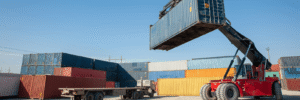What is intermodal transport? When is it worth using?
Choosing the right mode of transport is much more than just getting goods from point A to point B. For many companies, it is a strategic part of their business that affects operating costs, delivery times, cargo safety and compliance with current environmental requirements. In response to these needs, intermodal transport is becoming increasingly popular – a flexible solution that allows different modes of transport to be combined into a single, coherent process.
In this article, we explain what intermodal transport is, how it works in practice, what its advantages and disadvantages are, and when its use brings real benefits to companies operating in supply chains.
Intermodal transport – definition and key features

Intermodal transport is a method of transporting goods using at least two different modes of transport, with the entire load being moved within the same loading unit, e.g. a container, swap body or semi-trailer. Sometimes it is necessary to consolidate the load, e.g. in the case of goods from different senders or from several orders. Importantly, there is no need to reload the goods each time the mode of transport changes. This solution allows the advantages of different modes of transport to be combined effectively. Intermodal transport can be carried out domestically, internationally, continentally or intercontinentally.
It is worth noting that the entire process is usually carried out on the basis of a single transport contract, and a single logistics operator is responsible for its execution, which significantly simplifies supply chain management.
Several means of transport – one loading unit
As already mentioned, a key feature of intermodal transport is maintaining the same loading unit throughout the entire transport route, regardless of how many times the mode of transport changes. The goods are placed in a single container, a single semi-trailer or a specialised swap body and remain in this form from the moment of loading until delivery to their destination.
The most commonly used measure of such a unit in container transport is the TEU (Twenty-foot Equivalent Unit), which corresponds to a 20-foot container. For example, while a road train can carry a maximum of 2 TEU units, today’s largest ocean-going container ships have a capacity exceeding 23,700 TEU.
Differences between intermodal, multimodal and combined transport
The terms intermodal, multimodal and combined transport often appear in similar contexts, but they refer to different forms of transport. It is important to know the significant differences between them so as not to get confused when arranging the details of cargo movement:
- Intermodal transport involves the use of at least two modes of transport during the journey, but the goods travel in a single loading unit throughout the entire route, without the need to open it or tranship its contents.
- Multimodal transport is also based on a combination of different modes of transport, but allows for a change of loading unit. Transhipment may be necessary when moving from one stage of transport to the next.
- Combined transport is a specific type of intermodal transport. It assumes that the main part of the route is covered by rail, inland waterway or coastal shipping, while road transport is limited to the shortest possible delivery or collection sections.
Understanding these differences makes it easier to choose the right logistics model for your needs, depending on the type of cargo, the purpose of transport and your individual expectations in terms of costs and operational efficiency.
You may also be interested in: Freight forwarding – what is it? Types of domestic and international freight forwarding >>>
How does intermodal transport work in practice?
Although combining several modes of transport in a single shipment is a complex operation, well-designed intermodal transport works like a precisely synchronised mechanism. The key to success here is consistent organisation of the supply chain, in which each branch of transport performs a specific function and all stages are coordinated by a single operator or forwarder.

From loading goods to delivery to their destination
The process begins with the loading of goods into the appropriate loading unit – most often a container, but it can also be a swap body or semi-trailer. This is a crucial moment, because from this point until the shipment is delivered to the customer, the contents of the container remain unchanged.
After loading, the container goes to the terminal, from where it sets off on its journey. It may, for example, be transported by rail to the next leg of the route, then by sea, and finally delivered to the recipient by road. What distinguishes this model is the fact that no unloading of the goods themselves takes place when changing the means of transport. Only the vehicle or means of transport handling the loading unit is changed.
At every stage of intermodal transport, the most important factors are continuity, safety and optimisation – both in terms of time and cost.
The role of transhipment terminals and railway hubs
The entire process can only run smoothly if the appropriate infrastructure is in place. Specialised transhipment points – such as land terminals, sea and air ports and railway hubs – enable the smooth transfer of loading units between means of transport.
Terminals are equipped with appropriate cranes, overhead travelling cranes, high-storage trucks and automated container traffic management systems. It is at these terminals that the change of transport mode takes place, while maintaining the integrity of the cargo unit. Well-connected terminals are an absolute prerequisite for the efficient operation of intermodal transport, which is why investment in infrastructure is one of the key factors in the development of this form of transport.
It is worth knowing that intermodal transport in Poland currently uses modern terminals and increasingly well-connected logistics hubs, which translates into the growing availability of this form of transport in our country.
Advantages of intermodal transport – why choose it?
Intermodal transport is a solution that is gaining increasing recognition among companies operating in the transport and logistics industry – and for good reason. It offers a number of benefits that make it competitively priced for many businesses, as well as safer and more environmentally friendly than traditional forms of transport.

Cost optimisation and price competitiveness
One of the main reasons why companies decide to use intermodal transport is the possibility of significantly reducing operating costs, especially for longer routes. Thanks to the fact that the main part of the transport is carried out using the most efficient combination of transport modes for a given load – often including rail or sea – the total cost of transport is lower than in the case of a supply chain based solely on one mode of transport, e.g. road. In addition, the lack of need to reload the goods themselves eliminates labour and storage costs at intermediate stages.
It is also worth mentioning price stability – unlike road transport, which often reacts to seasonal changes in demand, intermodal transport is less susceptible to rate fluctuations throughout the year.
Ecology and care for the natural environment
For companies that pay close attention to sustainable development, intermodal transport is a natural choice. Transport operations that make optimal use of rail or inland waterways generate significantly lower carbon dioxide emissions compared to road and air transport.
On many routes, CO₂ emissions can be reduced by up to several dozen percent, which has a direct impact on reducing the carbon footprint of the transport. In addition, the reduction in heavy traffic translates into lower noise and air pollution in urban areas, as well as less wear and tear on road infrastructure.
No reloading of goods = greater cargo security
Due to the fact that the goods are transported in the same loading unit throughout the entire route, the risk of errors, damage or loss is significantly reduced. The fact that the cargo does not need to be reloaded when changing the means of transport eliminates one of the most critical moments in the logistics process.
The containers used are properly sealed, which further protects the cargo from any external interference. For many companies, especially those transporting high-value goods, it is precisely cargo security that is one of the main arguments in favour of intermodal transport.
Less paperwork, greater predictability and customisation
Organising the entire route on the basis of a single transport contract is a huge convenience for both the forwarder and the customer. There is no need to negotiate terms with multiple carriers – the entire process is supervised by a single operator who takes responsibility for the transport from start to finish. Intermodal transport thus reduces the risk of misunderstandings and allows for better control of deadlines. Transport becomes more predictable – and in logistics, this is a value in itself.
The possibility of combining different modes of transport allows you to optimally adapt the route and mode of transport to the specific nature of the cargo and the individual logistics needs of the company.
Disadvantages of intermodal transport – what should you keep in mind?
Although intermodal transport has many advantages, it is not without its drawbacks. To implement it effectively, you need to be well aware of both the potential difficulties and the requirements involved in its organisation. Below, we discuss the most important aspects to consider when planning this type of transport.

Longer transit times and less flexibility
One of the most frequently cited limitations of intermodal transport is its lower flexibility compared to road transport. Trains and ships operate according to fixed schedules, which cannot always be easily adapted to the current needs of a company. The frequency of rail and sea connections on selected routes may be limited, making it difficult to plan deliveries in more dynamic conditions.
For this reason, you have to take into account the possibility of longer transit times, especially if the cargo has to ‘wait’ for the next means of transport at the terminal. For urgent deliveries, this can be an insurmountable barrier.
Problems with real-time shipment monitoring
Unlike road transport, where modern telematics systems allow vehicles to be tracked almost every metre of their journey, intermodal transport does not always guarantee real-time shipment monitoring. In many cases, it is only possible to check the status of a container at checkpoints, e.g. at the time of clearance at a given port or during transhipment at a terminal.
For companies that need to know the exact location of their cargo at all times, this can be a significant limitation, ruling out this type of transport for their operations.
Costly infrastructure and the need for planning
The effective operation of intermodal transport also requires access to extensive infrastructure: transhipment terminals, storage yards, cranes, overhead travelling cranes, as well as well-connected rail and sea routes. Not every company has such resources or convenient access to them.
What is more, organising this type of transport requires very careful planning in advance and excellent knowledge of local regulations in different countries and the realities of the TSL industry. This is not a solution for quick, last-minute orders. Efficient coordination of all stages of transport is required, which can be a challenge, especially for smaller companies.
When is intermodal transport the best choice?
No form of transport is ideal for every situation, and this also applies to intermodal transport. If you want to fully exploit its potential, it is worth knowing under what conditions this option brings the greatest benefits, both financial and operational.

Long routes, large volumes and adequate infrastructure
Intermodal transport is becoming price-competitive primarily on longer routes, both domestic and international. The longer the journey, the more cost-effective it is to use rail or inland waterway transport for the main leg of the journey, limiting road transport to short journeys, e.g. between the terminal and the point of loading or unloading. In practice, intermodal transport works best on routes that combine sea and land transport, for example when it involves the transport of containers from seaports to logistics centres located inland.
Of course, the size of the load is also important here. Intermodal transport is particularly recommended for transporting large volumes of goods, especially when long distances have to be covered to reach the destination.
This model also offers significant benefits when the transport route passes through countries with well-developed intermodal infrastructure, especially in terms of rail transport, seaports and transhipment terminals.
Who can benefit from intermodal transport?
This solution is most often chosen by companies:
- transporting heavy loads (e.g. construction materials, industrial components),
- serving international supply chains,
- making regular deliveries on repetitive routes (especially long ones),
- looking for ways to reduce the impact of transport on the environment,
- expecting stable prices for transport regardless of the season.
Intermodal transport is also used in the e-commerce, automotive and manufacturing industries – wherever predictability and security of delivery are important.
Summary
Intermodal transport presents a modern approach to the organisation of freight transport, using different modes of transport in a single, coherent system. By using a single loading unit for the entire route, it is possible to avoid reloading the goods themselves en route, increasing their safety and improving cost control. Although this model requires careful planning and appropriate infrastructure, intermodal transport works very well on long routes, for large and heavy loads, and in international supply chains.
This solution is particularly worth considering when logistics is carried out on a larger scale and efficiency, predictability and resilience to the challenges of today’s market are required.
Frequently asked questions (FAQ)
What is the difference between intermodal and multimodal transport?
Both intermodal and multimodal transport involve the use of different modes of transport (at least two) within a single transport route. The key difference lies in the way the cargo is handled. In intermodal transport, the cargo remains in a single loading unit (e.g. in the same container) throughout the entire route, without any transhipment of the goods themselves. In multimodal transport, on the other hand, a change of unit is permitted, which means that the contents can be transhipped at different stages of the journey.
What are the types of intermodal transport?
Different types of intermodal transport result from the combination of transport modes used. These can be road-rail, road-sea, rail-road-sea, as well as road-air, rail-road-air, rail-road-river, rail-sea and rail-air connections. The key is that in each of these models, the goods reach their destination by travelling in the same loading unit throughout the entire transport process.
Is intermodal transport suitable for small shipments?
It is not an optimal solution for small loads, which are most often transported using a single mode of transport. Intermodal transport is based on transport in containers or other large loading units, so it is more cost-effective for larger or consolidated shipments.